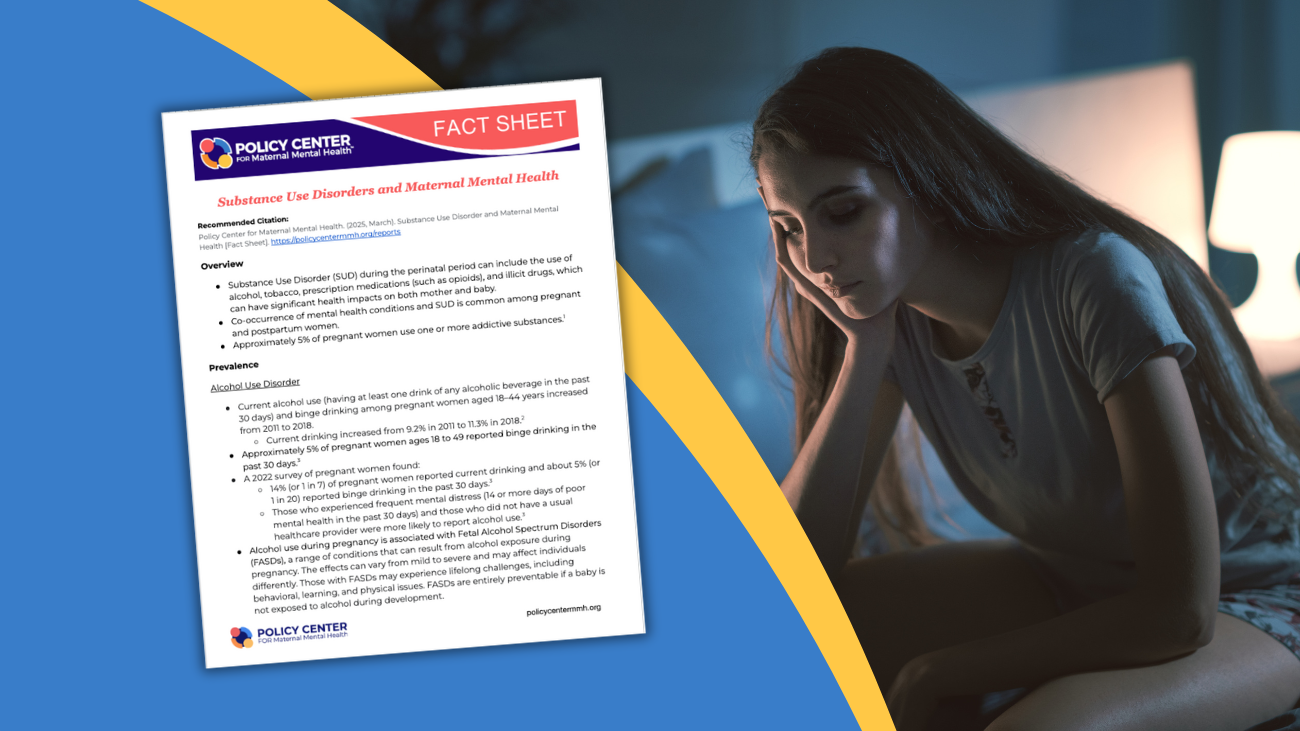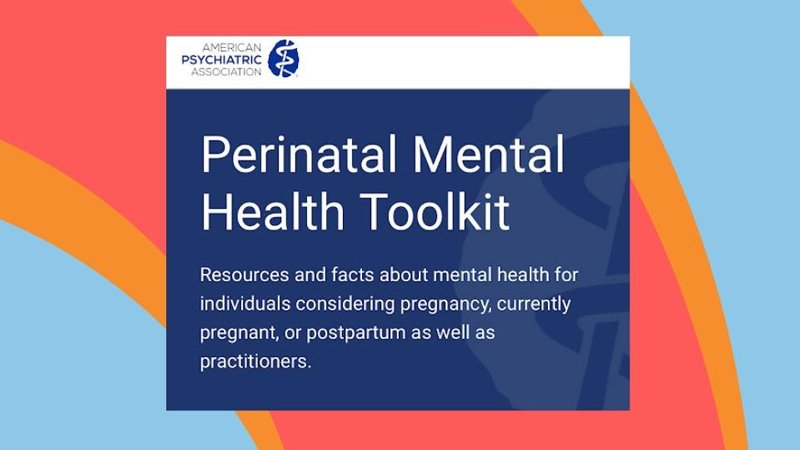Recommended Citation:
Policy Center for Maternal Mental Health. (2025, March). Substance Use Disorder and Maternal Mental Health [Fact Sheet]. https://www.doi.org/10.69764/SUDF2025
Take it To Go
Overview
- Substance Use Disorder (SUD) during the perinatal period can include the use of alcohol, tobacco, prescription medications (such as opioids), and illicit drugs, which can have significant health impacts on both mother and baby.
- Co-occurrence of mental health conditions and SUD is common among pregnant and postpartum women.
- Approximately 5% of pregnant women use one or more addictive substances.1
Prevalence
Alcohol Use Disorder
- Current alcohol use (having at least one drink of any alcoholic beverage in the past 30 days) and binge drinking among pregnant women aged 18–44 years increased from 2011 to 2018.
- Current drinking increased from 9.2% in 2011 to 11.3% in 2018.2
- Approximately 5% of pregnant women ages 18 to 49 reported binge drinking in the past 30 days.3
- A 2022 survey of pregnant women found:
- 14% (or 1 in 7) of pregnant women reported current drinking and about 5% (or 1 in 20) reported binge drinking in the past 30 days.3
- Those who experienced frequent mental distress (14 or more days of poor mental health in the past 30 days) and those who did not have a usual healthcare provider were more likely to report alcohol use.3
- Alcohol use during pregnancy is associated with Fetal Alcohol Spectrum Disorders (FASDs), a range of conditions that can result from alcohol exposure during pregnancy. The effects can vary from mild to severe and may affect individuals differently. Those with FASDs may experience lifelong challenges, including behavioral, learning, and physical issues. FASDs are entirely preventable if a baby is not exposed to alcohol during development.
- The prevalence of FASDs is currently unknown. The CDC has found that approximately 1 in 1,000 live births in certain areas of the United States result in an infant with Fetal Alcohol Syndrome (FAS).4 A more recent study analyzed medical records and identified FAS in 0.3 out of every 1,000 children aged 7 to 9 years.5
Marijuana Use
- Self-reported marijuana use during pregnancy ranges from 2% to 5% but is significantly higher (15–28%) among young, urban, and socioeconomically disadvantaged women. Usage rates tend to be higher when assessed at delivery rather than during prenatal visits, as some users may not seek prenatal care.6
- Between 34–60% of women who use marijuana continue during pregnancy, often due to the belief that it is relatively safe and more affordable than tobacco. Additionally, 18.1% of pregnant women who reported marijuana use in the past year met the criteria for marijuana abuse, dependence, or both.6
Illicit Drug Use and Opioid Use Disorder
- An annual average of approximately 21,000 pregnant women aged 15 to 44 reported past-month opioid misuse. This corresponds to 0.9 percent of pregnant women in this age group, which is lower than the 2.6 percent observed among nonpregnant women aged 15 to 44.7
- The opioid epidemic has led to a significant increase in Neonatal Abstinence Syndrome (NAS), a withdrawal syndrome that occurs in infants born to mothers using drugs during pregnancy, with cases rising fivefold between 2004 and 2014,8 corresponding with a rise in opioid use among pregnant women.7
- 5% of pregnant women aged 15–44 reported current illicit drug use.9
- Illicit drug use during pregnancy varies significantly with age. Teenaged pregnant women (ages 15–17) have the highest rates at 20.9%, followed by young adult women (18–25) at 8.2%, and adult women (26–44) at 2.2%.9
Maternal Mental Health & SUD
- More than 30% of pregnant women in substance use treatment screened positive for moderate to severe depression, and over 40% reported symptoms of postpartum depression.10
- Untreated maternal mental and substance use disorders are linked to high-risk pregnancies, poor infant health outcomes, and maternal mortality.11
- Adverse outcomes of untreated SUD include low birth weight, preterm birth, neonatal abstinence syndrome (NAS), impaired mother-infant bonding, and developmental delays.11
- Pregnant women with opioid use disorder (OUD) frequently have co-occurring mental health disorders, including depression, post-traumatic stress disorder (PTSD), and anxiety.10
- According to the CDC, suicide, and overdose are leading causes of maternal death within the first year postpartum.11
- Smoking and illicit drug use during pregnancy contribute to preterm birth, low birth weight, neonatal abstinence syndrome (NAS), and long-term cognitive and behavioral difficulties in children.12
- Tobacco use during pregnancy is linked to increased maternal depression and anxiety, creating a cycle where mental health struggles and nicotine addiction reinforce each other.12
- Pregnant individuals with illicit drug use disorders have higher rates of depression, anxiety, and PTSD, often using substances as a coping mechanism for underlying mental health issues.12
Barriers to Treatment
- Screening for perinatal mental health and substance use disorders is critical but inconsistently implemented.11
- Many healthcare providers lack training or feel uncomfortable treating perinatal mental health conditions as well as perinatal substance use disorder.11
- Only 13% of outpatient-only and residential substance use treatment facilities offered special treatment programs for pregnant/postpartum women. Among hospital inpatient treatment facilities, this figure was 7%.7
Impact on Mother and Baby
- The use of substances during pregnancy increases the risk of miscarriage, stillbirth, birth defects, and neonatal withdrawal symptoms.10
- Children born to mothers with untreated SUD or mental health conditions have a higher risk of developmental delays and behavioral issues.7
Treatment and Support
- Providing screening and treatment in obstetrics, which can include integrating psychiatric, and addiction care specialists into obstetric clinics improves treatment outcomes.13
- Therapies like cognitive behavioral therapy (CBT) help manage anxiety, depression, and substance use behaviors. Methadone or buprenorphine maintenance therapy is the standard treatment for opioid use disorder during pregnancy, improving outcomes for both mothers and infants compared to no treatment.7
- Peer support and community programs play a critical role in maternal recovery and well-being.14
References
- Wendell, A. D. (2013). Overview and epidemiology of substance abuse in pregnancy. Clinical Obstetrics and Gynecology, 56(1), 91–96. https://doi.org/10.1097/GRF.0b013e31827feeb9 ↩︎
- Denny, C. H., Acero, C. S., Terplan, M., & Kim, S. Y. (2020). Trends in Alcohol Use Among Pregnant Women in the U.S., 2011–2018. American Journal of Preventive Medicine, 59(5), 768–769. https://doi.org/10.1016/j.amepre.2020.05.017 ↩︎
- Gosdin, L. K., Deputy, N., Kim, S., Dang, E., & Denny, C. (2022). Alcohol Consumption and Binge Drinking During Pregnancy Among Adults Aged 18–49 Years—United States, 2018–2020. MMWR. Morbidity and Mortality Weekly Report, 71. https://doi.org/10.15585/mmwr.mm7101a2 ↩︎
- Centers for Disease Control and Prevention (CDC). (2002). Fetal Alcohol Syndrome—Alaska, Arizona, Colorado, and New York, 1995—1997. https://www.cdc.gov/mmwr/preview/mmwrhtml/mm5120a2.htm ↩︎
- Centers for Disease Control and Prevention (CDC). (2015). Fetal Alcohol Syndrome Among Children Aged 7–9 Years—Arizona, Colorado, and New York, 2010. https://www.cdc.gov/mmwr/preview/mmwrhtml/mm6403a2.htm?s_cid=mm6403a2_w ↩︎
- The American College of Obstetricians and Gynecologists. (2017). Marijuana Use During Pregnancy and Lactation. https://www.acog.org/clinical/clinical-guidance/committee-opinion/articles/2017/10/marijuana-use-during-pregnancy-and-lactation ↩︎
- Smith, K., & Lipari, R. (2017). Women of Childbearing Age and Opioids. Substance Abuse and Mental Health Services Administration (SAMHSA). https://www.samhsa.gov/data/sites/default/files/report_2724/ShortReport-2724.html ↩︎
- Patrick, S. W., Davis, M. M., Lehman, C. U., & Cooper, W. O. (2015). Increasing Incidence and Geographic Distribution of Neonatal Abstinence Syndrome: United States 2009-2012. Journal of Perinatology : Official Journal of the California Perinatal Association, 35(8), 650–655. https://doi.org/10.1038/jp.2015.36 ↩︎
- Stone, R. (2015). Pregnant women and substance use: Fear, stigma, and barriers to care. Health & Justice, 3(1), 2. https://doi.org/10.1186/s40352-015-0015-5 ↩︎
- The American College of Obstetricians and Gynecologists. (2017). Opioid Use and Opioid Use Disorder in Pregnancy. https://www.acog.org/clinical/clinical-guidance/committee-opinion/articles/2017/08/opioid-use-and-opioid-use-disorder-in-pregnancy ↩︎
- American Psychiatric Association. (2023). Perinatal Mental Health Toolkit. https://www.psychiatry.org:443/psychiatrists/practice/professional-interests/women-s-mental-health/maternal-mental-health-toolkit ↩︎
- Behnke, M., Smith, V. C., Committee on Substance Abuse, & Committee on Fetus and Newborn. (2013). Prenatal substance abuse: Short- and long-term effects on the exposed fetus. Pediatrics, 131(3), e1009-1024. https://doi.org/10.1542/peds.2012-3931 ↩︎
- Krans, E. E., & Patrick, S. W. (2016). Opioid Use Disorder in Pregnancy: Health Policy and Practice in the Midst of an Epidemic. Obstetrics and Gynecology, 128(1), 4–10. https://doi.org/10.1097/AOG.0000000000001446 ↩︎
- Policy Center for Maternal Mental Health. (n.d.). Maternal Mental Health Peer Support. Policy Center for Maternal Mental Health – Formerly 2020 Mom. Retrieved August 25, 2024, from https://policycentermmh.org/certified-peer-support/ ↩︎


